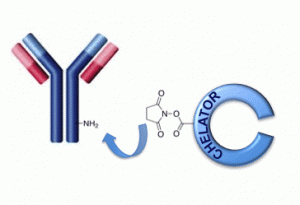The Chelator makes the difference
The in-vivo imaging of a biomolecule (peptide, protein, antibody, …) often requires the grafting of a chelator prior to the radiometallation step. Recent litterarure emphasized that a small modification of the chelator can significantly alter the pharmacokinetic of the conjugate. It is especially the case when the biological molecule is a small peptide or an antibody fragment.
DOTA is a gold standard to complex most of the radiometals. However, it is by far not always the ideal candidate. It is important to find the right combination between the chelating agent and the biovector. Many factors such as the size, the geometry, the lipophilicity and the charge of the metal complex can affect the pharmacokinetic of the drug.
During the design phase of a new radiopharmaceutical, it is crucial to screen very early, which chelate will be the most adapted in order to find the ideal system: chelator/radiometal/biovector.
All these considerations lead us to provide you several samples packs in order to give you the opportunity to test different chelating agents in a cost effective way.

